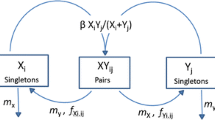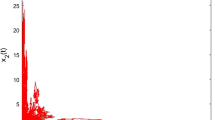Abstract
The terms “competition” and “allelopathy” should be used in ways consistent with some set of criteria, perhaps those proposed in this discussion. Proposed proof of competitive interference includes: (1) identification of the symptoms of interference; (2) demonstration that the presence of the agent is correlated with reduced utilization of resources by the suscept; (3) demonstration of which resource(s) depleted by the agent are limiting resources; and (4) simulation of that interference (in the absence of the agent) by reduction of the supply of resources to levels that occur during interference. Proposed proof of allelopathic interference includes: (1) identification of the symptoms of interference; (2) isolation, assay, characterization, and synthesis of the toxin; (3) simulation of the interference by supplying the toxin as it is supplied in nature; and (4) quantification of the release, movement, and uptake of the toxin. It would be desirable but not essential to show that the selectivity of the toxin to various species corresponds to the range of species affected by the allelopathic agent. We propose that fulfillment of the above criteria would constitute proof of competitive or allelopathic interference. According to these criteria, it is possible that neither competitive nor allelopathic interference has been unequivocally proven at the present time. These criteria are proposed as a basis for evaluation of experimental evidence and as an indicator of deficiencies in our technology.
Similar content being viewed by others
References
Agrios, G.N. 1969. Plant Pathology. Academic Press, New York, 629 pp.
Bell, D.T., andKoeppe, D.E. 1972. Noncompetitive effects of giant foxtail on the growth of corn.Agron. J. 64:321–325.
Egli, D.B., Pendleton, J.W., andPeters, D.B. 1970. Phytosynthetic rate of three soybean communities as related to carbon dioxide levels and solar radiation.Agron. J. 62:411–414.
Elakkad, M.A., andBehrens, R. 1978. Canada thistle (Cirsium arvense Scop.) competition with corn and soybeans for water, nutrients, and light.Weed Sci. Soc. Am. Abstr. p. 65.
Elliott, L.F., McCalla, T.M., andWaiss, A., Jr. 1978. Phytotoxicity associated with residue management, pp. 131–146,in W.R. Oschwald (ed.). Crop Residue Management Systems, ASA Special Publication Number 31, American Society of Agronomy, Madison, Wisconsin.
Halligan, J.P. 1976. Toxicity ofArtemisia californica to four associated herb species.Am. Midl. Nat. 95:406–421.
Harper, J.L. 1977. Population Biology of Plants. Academic Press, New York, 892 pp.
Harper, J.R., andBalke, N.E. 1981. Characterization of the inhibition of K+ absorption in oat roots by salicylic acid.Plant Physiol 68:1349–1353.
Johnston, T.J., Pendleton, J.W., Peters, D.B., andHicks, D.R. 1969. Influence of supplemental light on apparent photosynthesis, yield and yield components of soybeans (Glycinemax L.).Crop Sci. 9:577–581.
Kaminsky, R. 1981. The microbiol origin of the allelopathic potential ofAdenostoma fasciculatum H & A.Ecol. Monogr. 51(3):365–382.
Kimber, R.W.L. 1973. Phytotoxicity from plant residues. III. The relative effect on toxins and nitrogen immobilization on the germination and growth of wheat.Plant Soil 38:543–555.
Lockerman, R.H., andPutnam, A.R. 1981a. Growth inhibitors in cucumber plants and seeds.J. Am. Soc. Hortic. Sci. 106(4):418–422.
Lockerman, R.H., andPutnam, A.R. 1981b. Mechanisms for differential interference among cucumber (Cucumissativus L.) accessions.Bot. Gaz. 142(3):427–430.
Mac Daniels, L.H., andPinnow, D.L. 1976. Walnut toxicity, an unsolved problem.North Nut Grow Assoc. Proc. 77:114–122.
McCalla, T.M., andNorstadt, F.A. 1974. Toxicity problems in mulch tillage.Agric. Environ. 1:153–174.
Muller, C.H. 1969. Allelopathy as a factor in ecological process.Vegetatio 18:348–357.
Oliver, L.R., andSchreiber, M.M. 1974. Competition for CO2 in a heteroculture.Weed Sci. 22(2):125–130.
Platt, J.R. 1964. Strong inference.Science. 146:347–353.
Putnam, A.R., andDuke, W.B. 1974. Biological suppression of weeds: Evidence for allelopathy in accessions of cucumber.Science 185:370–372.
Rice, E.L. 1974. Allelopathy. Academic Press, New York, 353 pp.
Stowe, L.G. 1977. Allelopathy and its influence on the distribution of plants in an Illinois old field. PhD thesis, University of Chicago, 89 pp.
Tang, C.S., andYoung, C.C. 1982. Collection and identification of allelopathic compounds from the undisturbed root system of bigalta limpograss (Hemarthria altissima).Plant Physiol. 69:155–160.
Wallace, T. 1961. The Diagnosis of Mineral Deficiencies in Plants by Visual Symptoms, 2nd ed. enlarged. Chemical Publishing Co., New York.
Whittaker, R.H. 1970. The biochemical ecology of higher plants, pp. 43–70,in E. Sondheimer and J.B. Simeone, (eds.). Chemical Ecology. Academic Press, New York.
Zimdahl, R.L. 1980. Weed-Crop Competition. A Review. International Plant Protection Center, Corvallis, Oregon, 195 pp.
Author information
Authors and Affiliations
Additional information
Journal Article No. 10713 of the Michigan Agricultural Experiment Station. Supported by United States Department of Agriculture Competitive Grant 78-59-2261-0-1-060-1
Rights and permissions
About this article
Cite this article
Fuerst, E.P., Putnam, A.R. Separating the competitive and allelopathic components of interference. J Chem Ecol 9, 937–944 (1983). https://doi.org/10.1007/BF00982203
Received:
Revised:
Issue Date:
DOI: https://doi.org/10.1007/BF00982203




